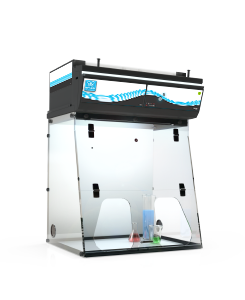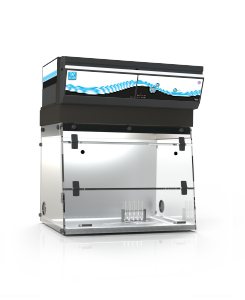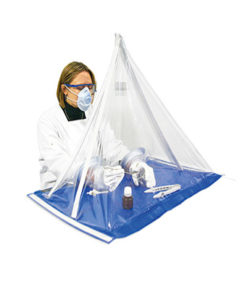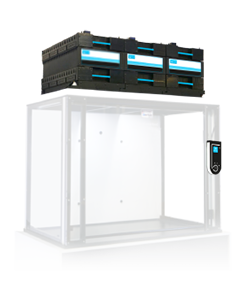Use of Filtered Hoods in Undergraduate Teaching and Research Laboratories
Featuring the Butler University Success Story as shared by Stacy O’Reilly from the Clowes Department of Chemistry and
Biochemistry, Butler University.
Overview
Indoor air quality impacts the health and safety of not only the people who work in a lab, but the equipment and products within the lab as well. Ductless fume hood systems are a safe, effective option to install in a lab to maintain a high level of wellbeing for lab users unfamiliar with this technology. However, it can be an intimidating process. What are the right questions to ask when considering this equipment, how can ductless fume hood systems minimize risk? How can these systems be incorporated into a lab facility’s risk management policies?
Answers to these questions and more are explored in the following narrative as shared by Professor Stacy O’Reilly professor of chemistry and biochemistry at Butler University. During a recent presentation sponsored by Lab Manager and Erlab, Inc., Prof. O’Reilly, conveys in detail her journey, experiences, and ultimate solutions for issues Butler’s laboratories were facing. The following is her story.
Assessing their choices
Butler’s existing HVAC system was inadequate to handle the air changes needed to mitigate odorous and harmful emissions while dealing with tremendous air quality issues. They had to make a choice, either upgrade their existing HVAC system, or examine alternative solutions. After a detailed analysis of what they would need to do to upgrade their HVAC, they decided it wasn’t financially feasible. The decision was made to add filtered fume hoods to reduce the HVAC load, improve safety, and increase their hood density all without having to upgrade their HVAC system.
By way of introduction – laying the groundwork
First of all, Butler University was founded in 1885. We’ve been on our current site since 1922. We are a master’s comprehensive institution. What does that mean? We have a select number of master’s program, but our bread and butter, the heart of our programs, are undergraduates between the ages of 18 and 23. That’s where we focus. We currently have 4,400 undergraduates.
We run at about 110 chemistry and biochemistry majors a year and about 200 chemistry minors. So we are a relatively large program. We also provide service courses for pre-meds. We have a large pharmacy program and we have a large health science major, and a very large biology program. We do a lot of courses at the introductory general chemistry and organic chemistry level. And then we also have a very rich, thriving chemistry major as well. We have 18 full-time faculty members, and we have two technical staff positions, so a good size program for an undergraduate institution.
My recent research data shows that the average age of a building, across the United States in higher ed, is 40 years old. The Ren building at William and Mary was constructed between 1695 and 1700. Now that’s not a science facility, but I do think it shows that academic buildings tend to withstand time, and need to be used for many, many years.
Growth at Butler
The home of sciences at Butler since the nineteen seventies is a lovely building, called Gallahue Hall. It is brutal modernistic, you can tell it belongs to the class of those big, beautiful concrete buildings that was built in the late 1960s. The design actually got underway in the mid to late 1960s. It was built in the early 1970s, and it has been used continually since 1974. On or about the early two thousands, we were running our laboratories at 90% capacity. We were running the labs, that is, 21 single laboratory teaching laboratories, anywhere from 20 to 25 hours of scheduled student time with the enrollment at 90% capacity, we were absolutely, positively at a breaking point. We simply needed more space as Butler was continuing to grow.
Working within outdated design parameters
There was, from the beginning, the built-in design residuals to deal with. You can be blessed or cursed with the decisions that were made in the design of a building that was created before, (and I’ll be honest here), I was born. Some of the Gallahue Hall building decisions that they made were due to budget, for example a science building built with only one freight elevator wouldn’t be my first choice. One of the unfortunate things back then, was designing specialty labs geared toward the work of specific individuals. The experimentation at the time in the department was very water based. It was also very analytical based, with quite a lot of physical chemistry. In comparison very little synthetic inorganic chemistry was undertaken, and very little synthetic organic metallic chemistry, and not much research, and active faculty usage. So, as research back then was very aqueous based fume hoods were not needed. You just needed to be able to work with acids and not worry about the organics. Many labs were designed this way, which we called- slot labs. They consisted of 10 feet high walls that completely closed off work by spots and that was your terrain. That was your domain, and an incredibly territorial, secretive design space.
Seeds of change
As the identity of the Butler student changed, emphasis shifted to undergraduate research which grew tremendously. The idea that you have a lab that gets used for a faculty member doing research when they feel like it during the summer became nonexistent, especially once research and teaching laboratories were literally being used all year long. In addition, rather than one faculty member in their space or zone doing their own thing, our own research became far more interdisciplinary.
Old buildings, maintenance issues & growing pains
When it came to addressing building deficit issues we suffered from the policy that ‘deferred maintenance’ became just that further deferred every year. Yes, older buildings leak. It would rain and we’d go from ice to snow, back to rain. Things would melt in the winter and I would literally have water running into my research laboratory. That was frustrating because as an organic, metallic chemist, I can’t have water and I can’t have oxygen invading the space. Regardless there were no updates to the heating, no updates to the cooling, no updates to the air handling system whatsoever. One of our least favorite equipment design flaws is rather than having up and down sashes, the existing hoods had back and forth ones. I got here in ’96 and the unpopular back and forth sashes had been removed from the hoods and lost. So instead of having fume hoods, we had these open caves that air would flow out of, and there was nothing safe about them. As time went on the decision in the department was made to hire more organic and synthetic chemist, but unfortunately there was literally no space that was appropriate.
Assessing the costs of dangerous lab air to human health
Not wanting to repeat the health mistakes of the past, a long hard look at chemical exposure and how to prevent it in new labs going forward was critical. The American chemical society says that students need 400 hours of lab experience over basically their three years, and their introductory lab doesn’t count. Teachers are also in the laboratories the whole time with students as well as active in additional research hours. I typically teach three, three-hour labs per week, and then also do undergraduate research. I’m often in the labs in excessive of 400 hours a year during a single academic year. So the exposure that we were finding for faculty was far, far greater than the exposure suffered by students. For students it’s short term, it’s just two semesters or it’s just four semesters but that didn’t take the health of the faculty into consideration. As was expected the faculty started having health issues.
For example: in one of the teaching organic labs, there was an accident and one of the faculty members was exposed to an organic chemical. The organic chemical caused what was confirmed as permanent damage to her breathing capacity. We didn’t know it was permanent at the time she was just working in the lab, then she started labored breathing. She came to me and said, I’m wheezing and I stepped in to see what could be done. Although I’m an asthmatic which bothers me occasionally, I had my albuterol because I knew what my issue was. We still don’t know what caused my colleagues breathing damage, we surmised a student may have cooked something too much and the fumes just went everywhere because we didn’t have a reasonable working HVAC system or any filtration that could pull the fumes away from our breathing zone. When exposed, she sought medical help and we reported it up the chain.
That was in November of 2010 and in December of 2010, our board of board of trustees, charged Butler administration and facilities personnel with creating a better environment and air quality by the start of the academic year in August, 2011. They promised a $22 million budget for this. It was wonderful to know our poor air environment would be rectified because it had been terrifying to see someone suffer the way my friend did and sad to know that she has breathing issues to this day. So my word of warning for all lab managers is to have your air tested and put safe guards in place before accidents happen. Don’t assume it is safe based on someone else’s assessment because the reality is the laboratory is where we work – everyday.
Planning for the future in the present requires vision
Our initial outlay for renovations was $2 million and we were given a short time frame to work within. I started by visiting a number of different lab sites for comparison and clues to what others were doing. The first thing I knew I wanted as chair of the department of chemistry was, without a doubt, working codes for each student. At this point in time the plan and the design of the project fell on me. We knew the buildings were in bad shape. We knew we needed more space and safer air. So I participated in not one but two, of what we called commissions on the sciences. These were fact finding missions to decide if we would renovate Gallahue Hall, or expand the science facility and what would that look like? We did one in 2010 and since one wasn’t good enough, we went back and did another one in 2014. Visiting other facilities gave us a great chance to look at other spaces, what was being done by colleagues and their methods, all of which led to formulating new ideas. In this phase of ‘smart planning’ one should be aware that some ideas are more costly when implemented, and usage, upkeep, and maintenance need careful consideration in any plan.
Seeking professional planning assistance and advice
Communication and updating were going to be key to all participating in the process; faculty, facilities and the administration. We needed to make sure we stayed within the board of trustees budget, but were at a loss as to whom we should bring to the table as consultants? Also, how do we start the conversation? We started planning our first meeting late December of 2010. We knew we were on a tight, eight-month timeframe. Our plan had to be cost-effective to hit the $2 million budget or the board wouldn’t approve it. The other tricky thing about this whole process was that we had to keep teaching. Classes could not be interrupted during the entire renovation period. This was going to require a flexible solution.
Looking at the big picture
We realized, early in the planning stages, that there was no way for a full retrofit and rebuild while still teaching classes. We needed to get creative. We couldn’t take the HVAC system out and reinstall it. How could we do this in a piecemeal fashion that allowed us to continue teaching in our spaces over the next eight months and still be within budget? At this juncture we sought help based on a previous informations from a previous grant proposal and from the vice president of facilities, who knew an architect with BA+A life structures named Jim Hill. This consultant was brought into the project in January of 2011. He knew far more about what was out there and what was available.
This consultant is the one who suggested we investigate green filtered, fume hood technology. Mr. Hill listened to the fact that every student in our organic chemistry lab needed to be in a hood without reworking the buildings entire air handling system. They were basically doing assignments on the countertop previously. This was literally the only solution available to us. Mr. Hill worked with faculty and facilities to develop a plan for January of 2011. So we started our small team planning with two faculty members, an architect, and a representative from facilities, working on a plan that included green, ductless fumehoods. Our project goals included the following:
Chemistry Teaching Labs: Project Goals
- Modernize Teaching Labs
- Improve Indoor Air Quality
- Relocate Instrument Lab to Improve Efficiency
- Reduce Operating Costs
Challenges:
- Limited Funding
- Limited Timeframe for Renovation
- Existing HVAC system, with Insufficient make-up
air:
‐14,970 CFM Supply Air
‐19,400 CFM Exhaust Air - Low floor-to-floor space restrictions
Plan implementation for guaranteed expected results
At our meeting, we reviewed design, the phasing of the project, how we would work through it, and of course, associated costs. We submitted that for approval in late February and the project began in April. We had received approval and funding from the board of trustees and Butler administration had also approved. Implementation on April 15th was the official ‘go’ date. We continued to teach in our laboratories and we started the process of prepping our stockroom. They did the first gut of one of our two teaching laboratories. They left one teaching laboratory intact while they gutted the other one, July first, we moved into the first teaching lab that was now fully renovated and then they gutted the second teaching laboratory. By August 15th, we had both laboratories completely finished. We were also able to do a more modest renovation of our general chemistry teaching laboratories in a similar manner.
Great results, on time, in budget
We were very pleased with the results, this is an image of what the organic teaching laboratories look like. And, as you can see, we definitely feature the Erlab filtered fume hoods. We finished the project on time, and loved the increased visibility created throughout the laboratories. It’s not just the fact that every student has a hood but also how much greater visibility we had for students working in the hoods. It’s a safer place for students. It’s a safer place for our faculty and our staff. We have been able to realize substantial energy savings from the filtered hoods. Because as I mentioned earlier, each of the organic laboratories originally had two 12 foot wide hoods without sashes causing an open zone that was gradually pulling air out.
As the air handling system had never been completely balanced the new filtered fume hoods help incredibly with air handling. When faced with issues of maintenance such as filter replacement, the proposal at the time was that any money that we would save in energy costs would be set aside in an endowment fund that would grow, and any cost of filters would be paid out of that endowed fund over time. It was decided this was a facilities expense.
Flexible Filtered Fume Hoods increased safety during COVID
We continued to update the space from 2011 to 2018. The edition has been just a huge benefit as well. We were able to use multiple rotovaps in our new enclosed filtered systems. As seen in the accompanying photo. They do not hurt line of sight as much as we were initially afraid that they would and they’ve been very useful as the space allows for additional work area, even with the rotovap equipment inside. The fact that the ductless
fume hoods are flexible and easily moved helped immensely when we were dealing with COVID space restrictions. Placing our rotovap equipment in the hoods also freed up countertop space for additional chemistry needs.
We utilize an MBR solvent dispensing system and we’ve added an Erlab filtered HALO unit to the ceiling above the system as well. And that has helped a lot in keeping the area and air around that unit free from harmful chemical/fume contamination.
Experience and takes aways
Take aways from our learning experience:
- Deliberate effort to be more interdisciplinary and more multifunctional
- Design space for growth
- Consider that labs are shared
- More misunderstanding incurred if no communication and buy in from colleagues
- One phase to go. December 2022
So how has this entire renovation of labs and equipment changed our department? Number one, we’re not sick all the time. After 26 years, I finally have a research lab that doesn’t leak. I don’t have an orange changed wall and I can go into my lab and not need to use albuterol. I am absolutely thrilled. We also learned a lot about planning and learned a great deal more about what goes into a space. Just the process alone was a learning experience that forced us to understand and think about new technology for better outcomes. It is often hard for people trained in the sciences in the 90’s to be open to new ways of thinking and experimenting and can require a leap of faith such as we participated in. For us though, there was only one option that would allow us to bring in and maintain clean air in our 1970’s laboratory building, without a full HVAC system overhaul, and that was ductless filtering fume hoods. I would recommend getting out in front of any faculty or facility objections by getting a new found perspective and understanding of filtered fume hoods – how they work, where and when they will work, and their safety factor, which through Erlab is guaranteed by their chemical analysis and certification program.
Erlab footnote: Equipment installed to date for Professor O’Reilly at Butler University
Filtered Fume Hoods:
(30) Green Solution Hoods by Air Master Systems featuring Erlab’s GreenFumeHood filtration technology.
(12) Erlab Captair 392 ductless filtering fume hoods.
(2) Erlab CaptairStore filtering storage cabinets.
(1) Erlab HALO laboratory Air Filtration System.











